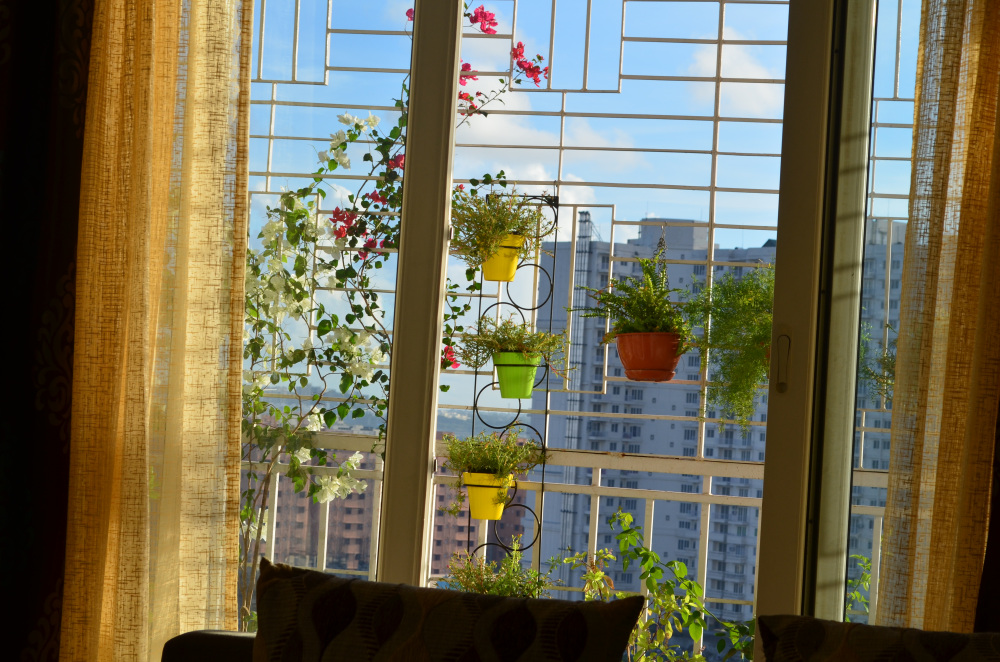The common notion is that air pollution is present only outdoors and hence once we are indoors we are absolutely safe from it and we have nothing to worry about. But, let me tell you, that we couldn’t be more wrong!
There is increasing evidence from researches showing that the indoor air pollution is actually much worse than outdoor air pollution. Wondering how that is even possible? Read on to know what are common culprits causing it and where are these pollutants lurking in our “supposedly ultra clean” homes. I have also included tips to help circumvent these issues to a large extent.
- Let the fresh air in
Good ventilation is one of the best and instant solutions to improve your indoor air quality.
With the soaring temperatures, the rise of air-conditioners had also increased phenomenally and as a result we have started spending our days in rooms with windows and doors shut and absolutely no air circulation. Now, with most of us stuck at home due to the quarantine, this is becoming a huge issue. Every day open windows and doors and allow fresh air to move into the house. Early mornings are the best time do this. Switch on the fans during this time to remove stagnant air contaminants. Use fans and exhausts in the kitchen to remove cooking fumes. .Airflow is crucial for removing stagnant air and replenishing fresh interior air. Being cooped up in non-ventilated spaces, makes the air quality really poor and this has a huge effect on your health, and mood. Poor indoor air quality has been linked to asthma, fatigue and lung disease.
There are also a number of factors contributing to indoor pollution like poor building materials as well as emissions from heating and cooling appliances.
First thing I do when I wake up is to go around my house opening the windows in all the rooms and opening the balcony doors. I slide open the curtains and tie them off and let fresh air and sunlight stream through. It instantly makes me feel fresh and rejuvenated.

- Change the filters
As mentioned above, the use of air-conditioners have increased and what we miss out is cleaning the filters often. Almost all air conditioners contain a type of filter that cleans the air, removing impurities and pollen. And without regular cleaning of the filters, dust and other airborne irritants, stay trapped instead them and keep re-circulating throughout your home. Therefore, it is very critical to regularly clean these filters as per the manufacturer’s instructions.
We regularly schedule cleaning of filters of our AC’s over the weekend. Frequency of cleaning depends on the frequency of usage of appliance.
- What’s in your furniture –
I know this might sound ridiculous, but your choice of furniture could be a cause of increase in your indoor air pollution. Certain materials used in your furnitures including the kind of foam for sofa and mattress, or industrial glue used in their manufacturing can contribute to air pollution. Many items of furniture are made with glues that continue to release toxins into the atmosphere, long after they have left the factory floor. This slow release of toxins can dramatically contribute to poor air quality. Choose your furniture carefully to avoid this slow poisoning. Try and avoid furniture made from particle board which contributes greatly to air pollution indoors.
We were conscious to make informed decisions when it came to purchasing our furnitures and mattresses. We were mostly successful though finding the best alternatives that suit your budget and style may be a challenge. But being aware is the first step towards taking wise decisions.
- Wall Paint – Ever wondered what’s in it
Typical paints we get in markets contain toxic substances that continue to emit gases/fumes long after the painting is over. It can lead to very poor air quality causing irritations and increase in allergies. If you are renovating your house, research well and invest in good chemical-free alternatives to ensure a healthy home for a long time. With increased awareness about this, there are many natural options available nowadays to choose from that don’t contain these harmful additives.
While re-painting our house, I researched alternatives and found eco-friendly options. Companies like Asian paints have come up with paints free of lead and heavy metals that comply with green standards.
- Use Natural cleaning products
When it comes to a clean home, it all boils down to using the right cleaning products. Wanting to have a clean house and using industrial chemical cleaner to achieve it equals, a totally defeated purpose. You know why? Because, cleaning just doesn’t meaning eliminating microbes. This 99.9% germ killing spree fueled by the media is the reason for an onset of large number of highly potent Industrial cleaners in the market. These cleaners leave toxic fumes and chemical residues behind that not only affect air quality but also adversely affects the gut bacteria and harms your immunity. What can you do? Don’t fall for media propaganda and Ditch chemical cleaners. Instead switch to using completely natural cleaning products such as lemon and vinegar that leave no toxic footprint behind.
I use my Homemade Bioenzymes for all my cleaning solutions and use natural cleaning products of all my cleaning needs.
You can learn how to make your own Bioenzyme too. It’s very easy – just click here to learn and start making your own natural cleaners.
To learn how to make a full range of cleaners and eliminate all the chemical cleaners, you can join my online workshop and learn how to make more than 20 different types of natural cleaners – Click here

- Include Indoor plants
To reduce the toxic chemicals in your home, bring in plants that clean the air to remove some of the toxic chemicals from indoor air. Many houseplants are great for removing formaldehyde, a common toxic chemical that may cause cancer and triggers allergic reactions and asthma attacks. Not only do the plants listed here improve indoor air quality, but they also brighten up any room with vibrant colors and rich textures.
I am sharing a few plants I constantly have in my house.
- Rubber Plant (Ficus elastica)- The rubber plant is at the top of the list for removing formaldehyde. The office is a great spot to place these plants because most office furniture is made from particleboard that is held together by formaldehyde-based glues.
- Spider Plant (Chlorophytum comosum)- These plants battle formaldehyde, carbon monoxide, and benzene. They also take care of xylene, a solvent used in rubber and leather, and in the printing industry.
- Peace Lily (Spathiphyllum)- These plants are ideal for removing formaldehyde, trichloroethylene, xylene, toluene, and benzene.
- Snake Plant (Sansevieria trifasciata)- The snake plant is one of the best indoor plants for ridding your home of dangerous formaldehyde, a chemical used in cleaning products, tissues, toilet paper, and personal care items.
- Golden Pothos (Scindapsus aureus)- One of the best houseplants for clean air, the golden pothos is a fast-growing plant that removes formaldehyde toxins.
- Areca Palm (Chrysalidocarpus lutescens)- In tests conducted by Dr. Wolverton, the Areca palm removed more toluene and xylene than any other plant. Toluene is one of the notorious ‘toxic trio’ (that also includes formaldehyde and dibutyl phthalate) known to be hazardous to human health. It’s most commonly found in paint thinners, nail polish remover, glues, and correction fluid. Xylene is used as a solvent in the printing, rubber, and leather industries. These chemicals make their way into our homes and offices and their long-term, cumulative impacts are unknown. Extremely effective at removing toxins from indoor air, the Areca palm also emits large amounts of water vapor—a boon in locations with dry air.
- Money Plant (Epipremnum Aureum):- This plant cleans the chemical toxins from the air and releases fresh air into the atmosphere, which keeps us healthy.
- Red-edged Dracaena (Dracaena marginata)- These plants are best for removing trichloroethylene, xylene, and formaldehyde.
I have some of these plants growing in my house currently. I have had each one of the above mentioned plants at some point or the other in my house.
Last but not the least;


Pic Courtesy – Author’s own
- Keep it clean
Regularly cleaning of bedding, drapes, and other items that tend to attract allergen is important. Airing out your mattresses and carpets must be done regularly.
Well, that about covers the most common pollutants that exists in our homes even without our knowledge and makes the air inside our homes harmful for us. I hope these pointers help you eliminate the common culprits and take some actions going forward.
Let me know in the comments if you have any other tips to improve the indoor air quality. I would love to know.
Until next time,
Kalpana




